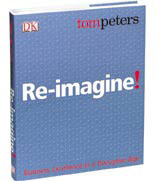Try taking a leaf out of a management book
Management evangelist Tom Peters is a champion of design, so long as it has that ‘Wow’ factor. Paul Foulkes-Arellano asks whether his latest tome possesses it

It’s rather a shock to find a management book that looks like the Guinness Book of Records, but Tom Peters, one of the most visible management gurus of the past 20 years, has teamed up with Dorling Kindersley to ‘reinvent the business book’.
The man who first made a splash with In Search of Excellence in 1982 has an enormous influence on current management thought across the globe. In keeping with his evangelising, the book’s message is backed up by the Peters website and various e-marketing initiatives. The book is also a manifestation of the Tom Peters brand (you can even buy the baseball cap at www.tompeters.com).
The content is equally furnished by Peters’ own inimitable style, and highlights the enormous rate of change in the corporate world. There are profound implications for business at large, but also design and the way forward for consultancies.
Peters is famed for his perceptive comments and many of his observations when applied to the design business are painfully true: ‘where excellent quality and timely service, powered by ubiquitous computing and communications devices, are commonplace… What does “special” look like when “runs like clockwork”[…] becomes merely the price of entry.’ This will ring true for many consultancy managers.
He also provides lots of sound advice that could relate to many design businesses: ‘Warring princes and princesses [must] grass over their moats.’
But of key interest is Peters’ insistence on the centrality of design to business strategy, inspired in part by the companies he studies, and in part by his wife, textile designer Susan Sargent.
Peters is a champion of great design; he is also an advocate of consigning poor design to the trash heap. He entreats managers across business to promote and undertake projects that ‘transform the enterprise’. Company boards should only green light those projects which have a profound ‘wow’ factor, he says. Given his influence on boards and senior management teams across the globe, this is brilliant news for purveyors of ‘wow’, though bad news for workmanlike design peddled by design conglomerates.
Design: The ‘soul’ of new enterprise
In Re-Imagine, Peters devotes two chapters to design and branding. He not only puts design and branding on the management agenda, but places it right at the top. This is unprecedented. In previous books, In The Pursuit of Wow and Circle of Innovation, Peters has talked up design, but has never regarded it as central to future business success.
Peters’ basic tenet is that companies which do not have a central board-level focus on design will fail and disappear, leaving only the likes of Apple and FedEx to rule the roost. Peters talks about design in its broadest sense – graphics, product, interiors – but moreover design in all customer/consumer interfaces. Design is the whole enterprise for Peters, not just the window dressing.
‘Designers are people who think with their hearts’
Peters warns against the process-driven company model take that so dominated the 1980s and 1990s. Peters advocates companies that emulate the outstanding design-led organisations and presents the reader with 17 examples of ‘highly design-driven companies’. He makes it simple by citing the iPod, Body Shop and BMW as matchless examples of great design.
Peters also highlights three solid examples of brand-driven companies: Harley-Davidson, The Gap and Virgin. Other choices we may question – more importantly Peters is attempting to get board-level arguments about design underway.
In essence, every Tom Peters book is a manifesto for reinventing your own department, your own business and the businesses of your customers. His thoughts and theorems are always extremely relevant to design businesses of every size.
Is the book a success? In design terms sometimes it is inspiring, sometimes it’s an illegible mess. Peters also creates a completely unique punctuational style – personally I love it, however, typographic purists might find it difficult to stomach.
A champion of design
With his many fans in the business world, the fact that Peters champions design, and devotes two whole chapters to design and branding in a business book, is a huge fillip to designers worldwide. I imagine many clients of design, present and future, will be reading Re-imagine this Christmas.
Paul Foulkes-Arellano is managing director of Wren & Rowe
What they say at business school
‘Tom Peters’ first major book, In Search of Excellence, identified the characteristics of companies that had been successful for a long period,’ writes Kai Peters (no relation), Ashridge Business School chief executive. ‘As time progressed not all remained so, forcing him to re-evaluate some of his original thinking. ‘What distinguishes Peters from many management gurus is that he never sticks to one perspective. He always has a knack of bringing together myriad trends and ideas. What’s consistent is Peters’ desire for action. Theorising is all very well, but getting on with the job and effecting real change is what’s really important to him. This is what makes Peters a cut above and his ideas well worth reading.’
-
Post a comment




